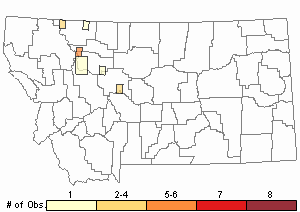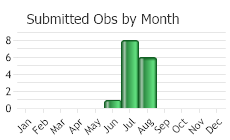View in other NatureServe Network Field Guides
NatureServe
Montana
Utah
Wyoming
Idaho
Wisconsin
British Columbia
South Carolina
Yukon
California
New York
Northern Wildrye - Elymus innovatus
Other Names:
Leymus innovatus
State Rank Reason (see State Rank above)
Rare in Montana, where it is currently known from a few scattered sites east of the Divide. Additional population data are needed for the species witin Montana. Population trends are unknown and two occurrences are only known from historical collections.
General Description
Northern Wild-rye is a perennial grass that forms small clumps of stems that are 4-8 dm high and which arise from creeping rhizomes. The stiff leaves are 2-4 mm wide and have inrolled margins; they are glabrous on top but minutely roughened on the bottoms. The membranous crest on the leaf where it meets the stem, or ligule, is ca. 1 mm high and has hairs on the upper margin. Spikelets are arranged opposite each other at each node in a narrow spike that is 4-9 cm long and located at the top of the stem. Spikelets are often purplish and have a pair of narrow, awn-tipped glumes at their base. They have 3-5 flowers, each of which has an awned, hairy lemma that is 5-12 mm long and a smaller palea.
Phenology
Fruiting in June and July.
Diagnostic Characteristics
E. GLAUCUS lacks rhizomes, and the leaf blades are 5-10 mm wide and the lemmas are smooth.
Species Range
Montana Range
Range Descriptions

 Native
Native
Range Comments
AK to B.C., east to Alta. and south to MT, WY, and SD. Peripheral.
Observations in Montana Natural Heritage Program Database
Number of Observations: 17
(Click on the following maps and charts to see full sized version)
Map Help and Descriptions
Relative Density

Recency



 (Observations spanning multiple months or years are excluded from time charts)
(Observations spanning multiple months or years are excluded from time charts)
Habitat
Moist meadows, forest margins and openings along rivers and streams in the valley and lower montane zones.
National Vegetation Classification System Groups Associated with this Species
Wetland and Riparian
Riparian and Wetland Forest
Stewardship Responsibility
Threats or Limiting Factors
STATE THREAT SCORE REASON
Threat impact not assigned because threats are not known (MTNHP Threat Assessment 2021).
References
- Literature Cited AboveLegend:
 View Online Publication
View Online Publication MTNHP Threat Assessment. 2021. State Threat Score Assignment and Assessment of Reported Threats from 2006 to 2021 for State-listed Vascular Plants. Botany Program, Montana Natural Heritage Program, Helena, Montana.
MTNHP Threat Assessment. 2021. State Threat Score Assignment and Assessment of Reported Threats from 2006 to 2021 for State-listed Vascular Plants. Botany Program, Montana Natural Heritage Program, Helena, Montana.
- Additional ReferencesLegend:
 View Online Publication
View Online Publication
Do you know of a citation we're missing? Lesica, P., M.T. Lavin, and P.F. Stickney. 2012. Manual of Montana Vascular Plants. Fort Worth, TX: BRIT Press. viii + 771 p.
Lesica, P., M.T. Lavin, and P.F. Stickney. 2012. Manual of Montana Vascular Plants. Fort Worth, TX: BRIT Press. viii + 771 p. Lesica, P., M.T. Lavin, and P.F. Stickney. 2022. Manual of Montana Vascular Plants, Second Edition. Fort Worth, TX: BRIT Press. viii + 779 p.
Lesica, P., M.T. Lavin, and P.F. Stickney. 2022. Manual of Montana Vascular Plants, Second Edition. Fort Worth, TX: BRIT Press. viii + 779 p.
- Web Search Engines for Articles on "Northern Wildrye"





